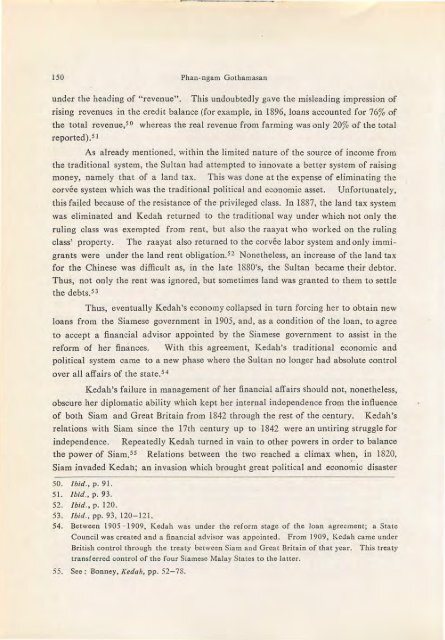The Journal of the Siam Society Vol. LXXII, Part 1-2, 1984 - Khamkoo
The Journal of the Siam Society Vol. LXXII, Part 1-2, 1984 - Khamkoo
The Journal of the Siam Society Vol. LXXII, Part 1-2, 1984 - Khamkoo
You also want an ePaper? Increase the reach of your titles
YUMPU automatically turns print PDFs into web optimized ePapers that Google loves.
150 Phan-ngam Gothamasan<br />
under <strong>the</strong> heading <strong>of</strong> "revenue".<br />
This undoubtedly gave <strong>the</strong> misleading impression <strong>of</strong><br />
rising revenues in <strong>the</strong> credit balance (for example, in 1896, loans accounted for 76% <strong>of</strong><br />
<strong>the</strong> total revenue, 5° whereas <strong>the</strong> real revenue from farming was only 20% <strong>of</strong> <strong>the</strong> total<br />
reported). 51<br />
As already mentioned, within <strong>the</strong> limited nature <strong>of</strong> <strong>the</strong> source <strong>of</strong> income from<br />
<strong>the</strong> traditional system, <strong>the</strong> Sultan had attempted to innovate a bettyr system <strong>of</strong> raising<br />
money, namely that <strong>of</strong> a land tax. This was done at <strong>the</strong> expense <strong>of</strong> eliminating <strong>the</strong><br />
corvee system which was <strong>the</strong> traditional political and economic asset. Unfortunately,<br />
this failed because <strong>of</strong> <strong>the</strong> resistance <strong>of</strong> <strong>the</strong> privileged class. In 1887, <strong>the</strong> land tax system<br />
was eliminated and Kedah returned to <strong>the</strong> traditional way under which not only <strong>the</strong><br />
ruling class was exempted from rent, but also <strong>the</strong> raayat who worked on <strong>the</strong> ruling<br />
class' property.<br />
<strong>The</strong> raayat also returned to <strong>the</strong> corvee labor system and only immigrants<br />
were under <strong>the</strong> land rent obligation. 5 2 None<strong>the</strong>less, an increase <strong>of</strong> <strong>the</strong> land tax<br />
for <strong>the</strong> Chinese was difficult as, in <strong>the</strong> late 1880's, <strong>the</strong> Sultan became <strong>the</strong>ir debtor.<br />
Thus, not only <strong>the</strong> rent was ignored, but sometimes land was granted to <strong>the</strong>m to settle<br />
<strong>the</strong> debts. 53<br />
Thus, eventually Kedah's economy collapsed in turn forcing her to obtain new<br />
loans from <strong>the</strong> <strong>Siam</strong>ese government in 1905, and, as a condition <strong>of</strong> <strong>the</strong> loan, to agree<br />
to accept a financial advisor appointed by <strong>the</strong> <strong>Siam</strong>ese government to assist in <strong>the</strong><br />
reform <strong>of</strong> her finances. With this agreement, Kedah's traditional economic and<br />
political system came to a new phase where <strong>the</strong> Sultan no longer had absolute control<br />
over all affairs <strong>of</strong> <strong>the</strong> state.s4<br />
Kedah's failure in management <strong>of</strong> her financial affairs should not, none<strong>the</strong>less,<br />
obscure her diplomatic ability which kept her internal independence from <strong>the</strong> influence<br />
<strong>of</strong> both <strong>Siam</strong> and Great Britain from 1842 through <strong>the</strong> rest <strong>of</strong> <strong>the</strong> century.<br />
Kedah's<br />
relations with <strong>Siam</strong> since <strong>the</strong> 17th century up to 1842 were an untiring struggle for<br />
independence. Repeatedly Kedah turned in vain to o<strong>the</strong>r powers in order to balance<br />
<strong>the</strong> power Of <strong>Siam</strong>.ss Relations between <strong>the</strong> two reached a climax when, in 1820,<br />
<strong>Siam</strong> invaded Kedah; an invasion which brought great political and economic disaster<br />
50. Ibid., p. 91.<br />
51. Ibid., p. 93.<br />
52. Ibid., p. 120.<br />
53. Ibid., pp. 93, 120-121.<br />
54. Between 1905 - 1909, Kedah was under <strong>the</strong> reform stage <strong>of</strong> <strong>the</strong> Joan agreement; a State<br />
Council was created and a financial advisor was appointed. From 1909, Kedah came under<br />
British control through <strong>the</strong> treaty between <strong>Siam</strong> and Great Britain <strong>of</strong> that year. This treaty<br />
transferred control <strong>of</strong> <strong>the</strong> four <strong>Siam</strong>ese Malay States to <strong>the</strong> latter.<br />
55. See: Bonney, Kedah, pp. 52-78.

















